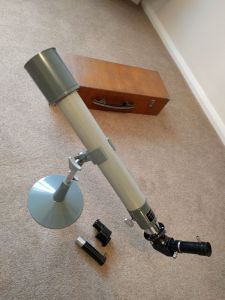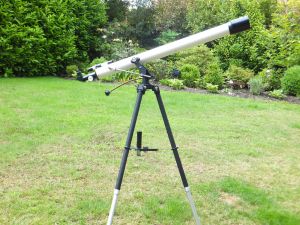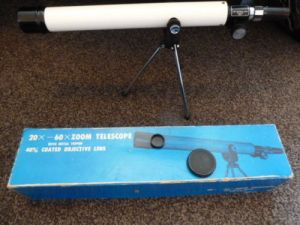This is a quick guide to the well known and often overlooked Tasco 50mm (2 inch) Refractor range. I’m not including the terrestrial versions or “spotters” as they’re commonly known, just the Astro versions. This guide is’nt meant to be a thorough guide to Tasco’s 50mm telescope collection, only an overview of my knowledge that i share freely and without recourse.
History
Tasco 6TE-5
To my knowledge the earliest Tasco 50mm is the 6TE, a Tabletop telescope supplied with a diagonal, 3 eyepieces and a tiny finderscope. Equiped with a Towa 50mm objective it gives very good views for it’s size. I have tested the views through two seperate 6TE’s and both were good performers. Mounted on a sturdier tripod these scopes are a joy to use. (I have seen an earlier version than mine with no finderscope just two aluminium peephole sights).

Tasco 66TE
Next in the lineup and by far the most common is the 66TE, now with a full size tripod with steel legs and a 2x barlow added to the accessories list. i have three of these models and all perform identically. If i had to choose between the 66TE and the earlier 6TE, i’d personally choose the earlier model. The optics are just a touch better in my 6TE. The eyepieces are all equal in performance. Usual focal lengths of supplied eyepieces are 20, 12.5 and 6mm. Although this model has a full size tripod it’s not the best but..! it’s better than the cheap flimsy aluminium type provided with todays chinese offerings.

Tasco 6TR-S
The 6TR-S (as far as i can tell) is the last telescope in Tasco’s 50mm lineup fitted with a Towa objective and performs as well as the previous 66TE . Now in “Radiant Red” this version is rare and widely avoided by astronomers “in the know” due to red tube Halley’s comet era telescopes that were vastly inferior to earlier versions. The 6TR-S is an exception to the red tube curse which we’ll get onto next. As you can see this version was a step back to tabletop mount but retained the 2x barlow.

Tasco 56T
The 56T is the last and most confusing model with a Japan variant. All previous models are fitted with Towa objectives but sadly the 56T is not. Now in the Halley’s comet boom for telescope sales most manufacturers were looking at cutting costs to maximise sales. This costcutting lead to the common belief that the “red tube” telescopes of the era were junk scopes. Tasco had some really good red tube scopes like the 6TR-S above and the Tasco/Vixen9VR 60mm, both replaced by models by Tanzutsu (diamond Z) the focusers are marked “Japan <Z>” . I briefly owned a Tanzutsu 56T but it was a disappointment after the Towa models. The reason the 56T is so confusing is because it was made in Japan then Korea and lastly Taiwan.

Tasco 45T
Last but not least the Chinese Tasco’s. Again a variable bunch! seen most commonly as the “Novice” or starter telescopes, the 5T and 45T are exactly what people expect of cheap chinese telescopes. all plastic and primarily aimed at children. Sometimes bundled with a Microscope, these models usually have a single lens objective instead of the much superior Achromat, though derided it’s still a telescope and will still give a basic astro experience. I can’t recommend these models as i know there are better telescopes for the same cost available from other manufacturers.

The end bit…..
In conclusion to the above i’ve got to state a few truths. The early Tasco’s are so much better than todays offerings from the company. The Japanese low cost telescope has been replaced by cheaper chinese competition, but not all chinese telescopes are as poor quality as the Tasco novice versions.
My Zennox 50×600 performs far better than the <Z> Tanzutsu Japanese 56T! most people would be surprised at just how well some modern chinese telescopes perform. Tasco aren’t the only manufacturer to cut costs at the expense of performance (read my Celestron 50 review) but they are responsible for turning whole generations away from small affordable telescopes.
The “red tube” curse is entirely a Tasco thing, though other manufacturers are heading down the same route by allowing their brand to be stamped on some truly atrocious telescopes. Maybe one day Tasco will start supplying beginners with better quality astro gear but who knows?
i hope you’ve enjoyed reading my thoughts on these models but remember, these are only my opinions and you should make your own choices and form your opinions by experience. good luck








